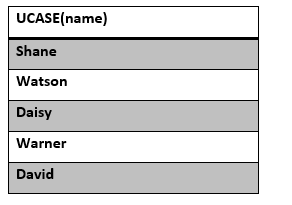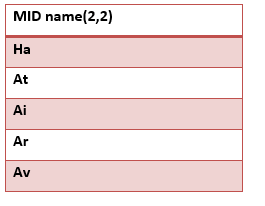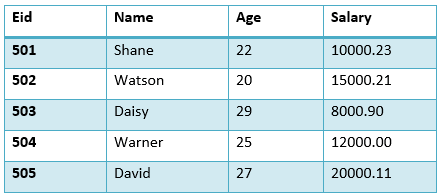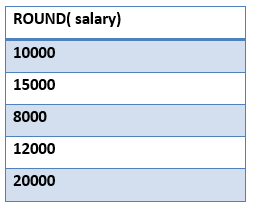SQL Tutorial
SQL Database
SQL Table
SQL Select
SQL Order By
SQL Insert
SQL Update
SQL Delete
Difference
SQL Injection
SQL String Functions
Miscl
- SQL Formatter
- SQL group by
- SQL add/drop/update column operation
- SQL CAST Function
- SQL Comments
- SQL CONCAT Function
- CTE (Common Table Expression)SQL
- How to use distinct in SQL?
- Joining Three or More Tables in SQL
- What is Web SQL?
- How to create functions in SQL?
- How to run SQL Script?
- How to Delete Duplicate Rows in SQL?
- Nth Highest salary
- 12 Codd's Rules
- SQL EXCEPT
- Types of SQL JOIN
- Change datatype of column in SQL
- SQL Auto Increment
- SQL Like
- Commit and Rollback in SQL
- SQL Concatenate
- SQL get month from the date
- Savepoint in SQL
- SQL ORDER BY DATE
- TIME Datatype in SQL
- SQL BETWEEN
- CRUD Operations in SQL
- SQL INDEX
- Scalar Functions in SQL
- SET Operators in SQL
- Types of SQL Commands
- TCL Commands in SQL
- SQL Subquery
- SQL View
- Constraints in SQL
- Pattern Matching in SQL
- SQL Date Functions
- DDL Commands in SQL
- DML Commands in SQL
- SQL CASE
- SQL Inner Join
- SQL IN Operator
- Check Constraint in SQL
- SQL CLAUSES
- SQL LOGICAL OPERATORS
- Delete Column from Table
- Add Column in the Table
- Delete one row in SQL
- Change the Column Value
- How to Add Foreign Key in SQL
- Add a Primary Key
- Insert One or More rows
- How to Use LIKE in SQL
- Cursor in SQL
- Difference Between DROP and Truncate
- SQL Comparison Operators
- SQL COUNT WHERE
- SQL SELECT MIN
- SQL Stored Procedure
- SQL SELECT AVG
- SQL SELECT MAX
- SQL ADD COLUMN
- How to use Auto-Increment in SQL
- SQL Languages
- SQL Arithmetic Operators
- How to Use GROUP BY in SQL
- How to Use ORDER BY in SQL
- Trigger in SQL
- What is Race Condition
- SQL COUNT DISTINCT
PL/SQL Tutorial
Sql Interview Question
SQl Quiz
How to create functions in SQL?
SQL has many built-in functions for performing the calculation of data. SQL provides built-in functions to perform the operations. Some useful functions of SQL are performing the mathematical calculations, string concatenation and sub-string etc.
SQL functions are divided into two parts:
- Aggregate Functions
- Scalar Functions
SQL Aggregate Functions
SQL Aggregate functions return a single value which is calculated from the values.
- AVG(): It returns the average value of the column.
- COUNT(): It returns the number of rows in the table.
- FIRST(): It returns the first value of the column.
- LAST(): It returns the last value
- MAX(): It returns the largest value of the column.
- MIN(): It returns the smallest value of the column.
- SUM(): It returns the sum of rows of the table.
SQL Scalar functions
SQL Scalar functions returns the single value according to the input value.
Scalar functions:
- UCASE(): It converts the database field to uppercase.
- LCASE(): It converts a field to lowercase.
- MID(): It extracts characters from the text field.
- LEN(): It returns the length of a text field.
- ROUND(): It rounds a numeric field to the number of decimals.
- NOW(): It returns the current date and time.
- FORMAT(): It formats how a field is to be displayed.
Aggregate Functions
The aggregate functions return a single value after performing calculations on the group of values. Some of Aggregate functions are explained below.
AVG Function
AVG () returns the average value of the database after calculating the values in numeric column.
Syntax :
Using AVG() function
Consider the following Emp table:

The following SQL calculates the average salary of the employees.
- SELECT avg(salary) from Emp;
Result:

COUNT() Function
Count returns the number of rows which are present in the database, and either it is based on the condition or without condition.
Its basic syntax is,
Using COUNT() function
Consider the following Emp table:

SQL query to count the number of rows that satisfies the condition.
Output:

Example of COUNT (distinct)
Consider the following Emp table:

The SQL query is:
Output:

FIRST() Function
The function returns the first value of the specified column.
Syntax:
Using FIRST() function
Consider the following Emp table:

The SQL query will be:
Output:

LAST() Function
The LAST function returns the return last value of the selected column.
Syntax of the LAST function is:
Using LAST() function
Consider the following Emp table:

SQL Query is:
Output:

MAX() Function
MAX() function returns the maximum value from the selected column of the table.
Syntax:
Consider the following Emp table:

The following SQL query fetch the maximum salary.
Output:

MIN() Function
MIN function returns the minimum value of selected column.
The syntax of MIN function:
Using MIN () function
Consider the below Emp table:

SQL query to find the minimum salary:
Output:

SUM() Function
SUM () function returns the total of the specified columns.
The syntax for SUM:
See the following Emp table

Sum of salaries are:
Output:

Scalar Functions
Scalar functions return a single value from an input value. Some of the Scalar functions are given below:
UCASE () Function
UCASE () converts the value of the string column into the Uppercase (Capital) characters.
Syntax
Using UCASE() function
Consider the below Emp table:

SQL query of UCASE:
Result:

LCASE() Function
LCASE() function is used to convert the value of string columns to Lowercase.
The syntax for LCASE:
Using LCASE() function
Consider the following Emp table

SQL query for converting the string value to Lowercase:
Output:

MID() Function
MID() function is used to extract substrings from column values in the table.
The syntax for the MID function is:
Using MID() function
Consider the following Emp table:

The following SQL query returns the substring start from the second character.
Output:

ROUND() Function
The ROUND() function is used to round a numeric field to a number of the nearest integer. It is used for decimal point.
Syntax:
Using ROUND() function
Consider the following Emp table:

The following SQL query rounds the amount of salary column.
Output:



